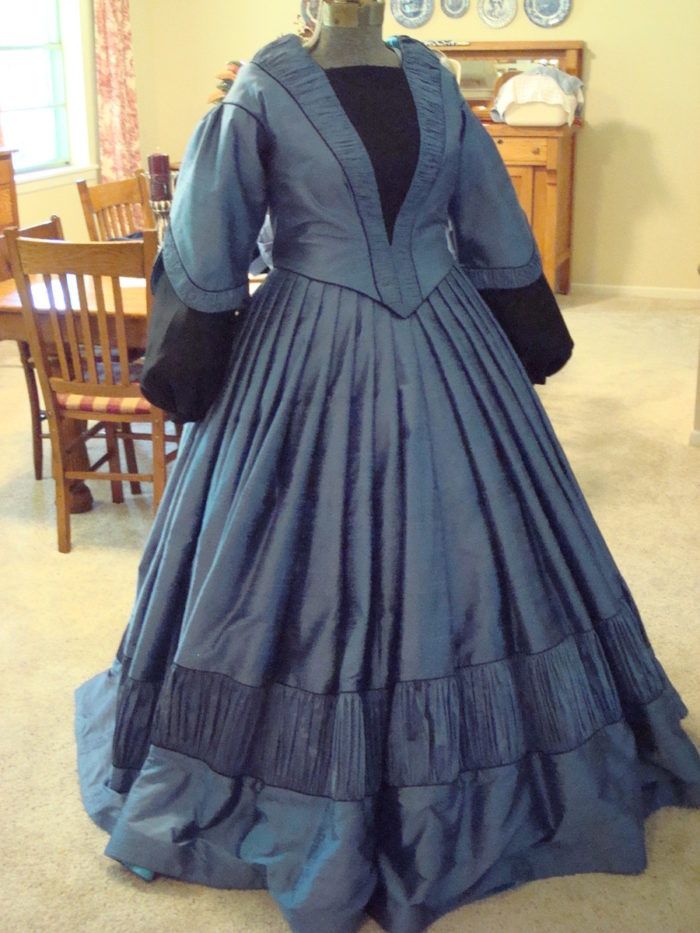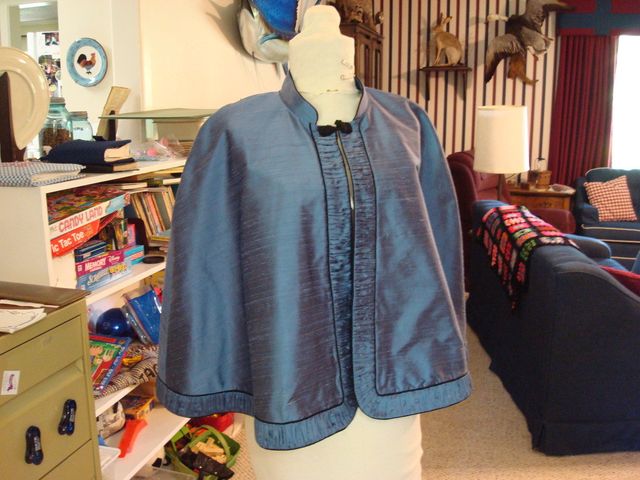
A delightful lady wanted me to create a new 1860’s ensemble for her. We designed it together having been been influenced by photos, research and her likes & dislikes. 40 yds. of silk dupioni and lots of hours resulted in the “evening wear” fitted top with self ruching and black silk piping detail. The center insert and the undersleeves are black silk organza. The fully lined pleated skirt, worn in both outfits, is 300 inches around the hem. The fully lined cape is also part of the “evening wear” as well as a “reticule” (purse) and ostrich and Russian veiling head piece. A blouse with pintucks on the bodice front and on the sleeves is worn under the black velvet “Zouave” jacket with pagoda sleeve for an “afternoon” outfit. The outfit is completed by a black faille “City Bonnet” lined in black silk.





























Your dress is absolutely amazing. Applaud - Applaud.
Stunning! I hope you got a good price on all that silk! I sure wish we were dressing like this today but have you ever tried to get into a sub-compact car in a corset!??? It's extremely difficult to say nothing of seat belting, reversing out of the driveway, etc.
You're a credit to seamstresses and I hope your client had a ball in her gown.
wow its fantastic. I have a pattern from a commercial firm & thats my next years challenge at the sewing guild. You are such an amazing seamstresss & such an inspiration that now I will try instaed of putting it off as I have had the material & pattern for many months. Thank you
Hi. I just wanted to say it's a beautiful dress
But from looking at it, I knew something was a little off, period wise. I thought perhaps the color choice and the way the skirt hangs.
I ran it by our group at The Sewing Academy, where several of the members both re-enact history, from 1840 and on, some professionally, and they have a combined expertise in this field that is outstanding.
I thought you might be interested in both the group and what they had to say about your dress.
Their comments can be found here:
http://thesewingacademy.org/index.php?topic=4068.0
It really is a lovely dress, and everyone praised how well it was sewn.
Hello, everyone. This is my first posting. I have been sewing for about 30 years. Guess I would categorize myself as intermediate. Does anyone have any suggestions as to how to improve being a seamstress - to get to the level of being able to sew an outfit such as this? I see many beautifulcreations both here and in other magazines, but don't want to waste time and money and try a project that is beyond my expertise.
Any suggestions on how to improve one's techniques would be most appreciated!
Catlover in Philadelphia
To Catlover: Since I started subscribing to Threads (years and years ago) I've learned a lot! I clip and file all the fitting articles plus many other articles from every issue. They are all filed or put in my "Tips and Techniques" notebook. I refer to these articles often for both ideas and techniques on things that I don't do very often. Just this past week I made a wool suit using an article on bound buttonholes and a back embellishment that I had seen. so my advice to you is read both from Threads and other books on fitting, etc. Practice too--sometimes it takes several tries to perfect a technique. The thing I tell my Beginner Sewing students is to keep sewing anything and everything because practice does make a difference! I absolutely love going to work at my sewing machine every single day!
Dear alotofstitches, thank you for answering me so promptly. I think my problem is I get frustrated easily and if I don't get something the first go-round, I become discouraged. I'm going to take your advice and keep practicing techniques.
I assume from your profile you have your own business. Do you also have private students?
Thanks for your response.
catlover in Phila.
To catlover-- yes, I have my own business and yes, I do some private lessons. A former beginner sewing student has begun a lined jacket to go with her lined skirt that she made in the Intermediate Sewing class. She has a desire to learn and catches on quickly. After her first class in March '08, she went on to sew quite a bit thru the summer, took the intermediate class in the fall and then wanted to make a jacket to go with her skirt. I'm quite proud of her!
WOW! Looks like lots of hours and it is TRULY beautiful!
I can appreciate the time and absolute perfection you put into the dress. I have a question about the way you lined the skirt. I am sewing my daughter's wedding dress and she wants the same look , not as full as yours. I am using dupioni silk, and the inside lining is batiste. I have been considering adding a layer of cotton flannel (light drapery interlining)to the silk, treating the 2 as one fabric. What did you do to get that beautiful silk, if you don't mind sharing? Thanks
To luvat1stsew: I love your name and I agree! Re: the silk skirt--all wedding gowns I've altered have a lining of either poly or acetate, something that is slick and moves easily, that is sew to the hem of the silk and then a 2nd lining hanging freely that is next to the skin. If a crinoline is added for fullness it'd be sewn to the free-hanging lining ending about 2 in. shorter than the skirt for walking ease. I cut a silk skirt, a acetate lining skirt, then a 2nd lining skirt. The silk and lining skirts had all side seams sewn, finished, pressed open, then the bottom edges aligned, right sides together with the lining extending 1/4-1/2 inch past silk. Seam is sewn, press as sewn then skirt turned: the lining turns to inside with the silk showing on the inside of skirt by either the 1/4 or 1/2 inch. Press lightly. I went back inside the skirt and added 2 inch horsehair braid scooted down into the hem fold sew it to the seam only. Sorry I can't explain how here. This is another detail in better bridal gown and it makes the skirt flow as she walks--beautiful! Meet the waistline edges of the skirt, add 2nd lining & band. If you have no band for the wedding gown, leave the back skirt seam open to be able to get inside the skirt--it's closed much like a sleeve lining in a jacket. note: I have seen some A-line w.gowns with a bridal underlining or crinoline used to support the skirt for a smooth A shape. I use acetate lining because it breathes and is more comfortable to wear. Batiste will not allow the fabrics to glide over each other. If I left something off let me know.
Congratulations on drafting and sewing such a good reproduction!! I have worked for 24 years as a "historic costume specialist" at a 1860's living history museum and I don't think I could do any better. You are more than a seamstress you are a clothing historian keep up the great work